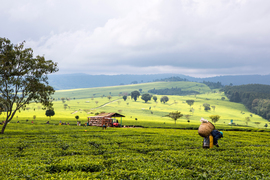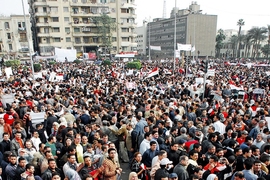Protestors acting against repressive regimes face a particular problem: The tools they use to organize demonstrations can also be deployed to repress their actions. For instance, when citizens communicate on the internet to plan a protest, a ruling regime can access that information and be ready to break up the demonstration. Then what?
What happens next, according to MIT political scientist Mai Hassan, is that protestors can engage in “coordinated discoordination,” as she calls it, finding ways to rapidly create new demonstrations, divert security forces, and keep social movements active, even in the face of regimes working to stop them.
“You need people to be on the same page for any sort of antiregime mobilization to occur, and that’s easiest done through a formal organization like a labor union or opposition political party, or in recent years, the internet, including Facebook events or Twitter,” Hassan says. “But that just brings out a fundamental tension, which is that dissidents make themself identifiable and findable to the very regime they’re trying to overcome. How do you organize when organizing makes it easier for the regime to engage in repression?”
Hassan has written about this topic in a new paper based on research she conducted on the ground in Sudan in recent years, where public movements sprang up in protest of the autocratic former ruler, Omar al-Bashir. By interviewing many protestors and studying their tactics, she was able to identify protest dynamics that would not otherwise be visible. She concluded, as she writes in the paper, that “social protest movements must perpetually innovate.”
The open-access paper, “Coordinated Dis-Coordination,” appears in advance online form in the American Political Science Review. Hassan is the sole author.
Hassan conducted her research from December 2018 to December 2019, interviewing over 100 focus groups and people who were participating in the protest movement against al-Bashir, who had seized power in 1989. It took time to identify some key protest leaders and talk with people trying to keep a low profile in certain regards; some belonged to what the Sudanese call “Lijān”, or informal neighborhood resistance committees in greater Khartoum, by far Sudan’s biggest metropolitan area.
What emerged from Hassan’s research is not a quantitative study, although that is characteristic of much of her other work, which has often examined rights and policies in recent Kenyan history. It is, however, an empirical study of fleeting, evolving protest tactics that have proven difficult to capture via traditional forms of political science measurement.
As Hassan observed, the largest protest group in Sudan at the time was a loose-knit alliance of formal groups and interests called the Forces for Freedom and Change (FFC), who organized many of the largest protest events. But when Sudan’s government security forces started tracking these events closely and breaking them up, grassroots participants began organically concocting what Hassan terms “parallel” activities in addition to these main events.
Hassan observed two major types of activities that protestors used while adapting to the regime’s security efforts. One, which she calls “jittering,” was the fairly spontaneous formation of protest events, at the same time as major, preplanned rallies but at multiple locations around the urban area, to take advantage of the heavy security focus on the major events. In this way more protests could occur with a lower proportion of police forces present.
Secondly, protestors began staging events that she terms “takhfīf,” or alternate demonstrations that would spring up once police forces began to break up preplanned events. Here, the precise aim was to draw security forces away from events where the response had begun to turn violent. (The word “takhfīf” means “lightening” or “reducing” in Arabic, as in reducing the burden on the main demonstration.) Protestors often briefly used social media platforms or other communications technologies to gather information about the status of a rally and decide if they should initiate a takhfīf event.
“These people are really brave and innovative,” Hassan observes. “These ideas cropped up among different lijān. They weren’t centrally organized by the FFC.”
A necessary condition of this dynamic, Hassan notes, is that Sudan has existed as a fairly weak state, without enormous social control or the huge capacity needed to severely crack down on protest movements.
“Many dissidents saw themselves as engaged in a cat-and-mouse game against the regime, trying to wear the regime down,” Hassan says. “They constantly reiterated that they were facing off against a weak state, that the regime was not strong. Some of these officers repressing them were their neighbors, and they could see the officers’ wives no longer shopping for clothes or buying the best cuts of meat at the grocery store. People got the idea that with their diminishing salaries, officer morale had to be down, so the activists’ idea was, we have to wear them down.”
Even if Sudanese-style protest tactics cannot work everywhere, a key point of Hassan’s study is to capture the evolution of them in a short time period, to chronicle how such adaptations are necessary.
Many scholars have studied the “Arab Spring” protests in the early 2010s, for instance, and concluded that social media platforms were vital to those mass demonstrations. But once authoritarian regimes observed protestors organizing on, say, Facebook, they began to quickly crack down on such efforts.
“A lot of [research] on the Arab Spring examines the role of social media, and it did have a role and caught some regimes off guard, but that’s only going to happen once,” Hassan says. Her question is: How can protestors sustain themselves after regimes have become more social media-savvy? The Sudanese case is one example, but Hassan hopes scholars will continue to examine the evolution of social movements globally, while keeping in mind that ongoing changes and innovations in their tactics are necessary.
“It’s not that repression is going to cause all movements to engage in these [precise] tactics,” Hassan says. “It’s that repression is going to force people to engage in tactics we haven’t thought about yet. If people are mobilizing in a particular way, the regime has an opportunity to learn and stop that form of mobilizing from happening. In a sense, protest tactics have to be random and unpredictable to work.”









